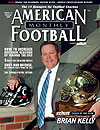Article CategoriesAFM Magazine
|
The Shot-Run OffenseQB Running Plays from the Gunby: Max Hausey Head Coach Grinnell College © More from this issue I have had two 1,000-yard rushers at quarterback and one who rushed for 700 yards and threw for 2,300 yards. Both of the 1,000-yard rushing quarterbacks also threw for 2,000 yards. Obviously, I like to utilize the quarterback in the running game. If you have a quarterback who can run, but maybe is not the best at the zone read play, I have some very effective and simple running plays for the quarterback. The running plays will also help slow down the defensive line’s pass rush. Quarterback Tackle Trap
|
|
|||||||
| HOME |
MAGAZINE |
SUBSCRIBE | ONLINE COLUMNISTS | COACHING VIDEOS |
Copyright 2025, AmericanFootballMonthly.com
All Rights Reserved





